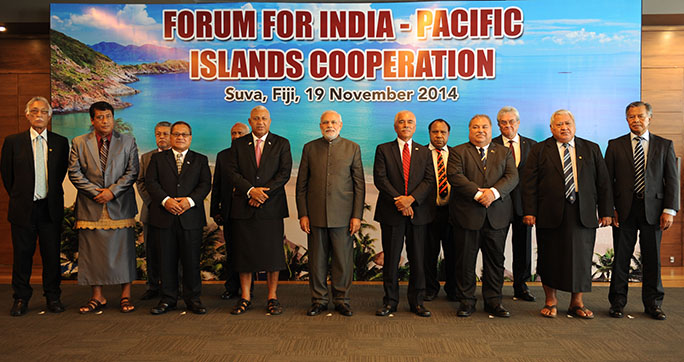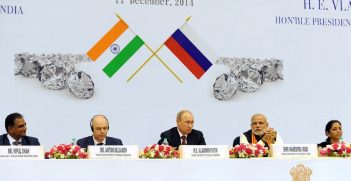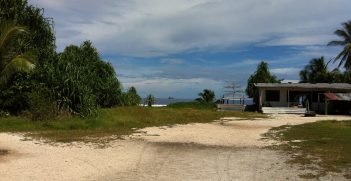The Secret Romance of India and the South Pacific Island Countries

India and the nations of the South Pacific have long engaged in meaningful bilateral and multilateral relationships. With the re-introduction of the Indo-Pacific as a geostrategic reality, it becomes all the more important for India to expand its relations with the island nations of this region.
India’s strategic orientation has been increasingly inclined towards the Southeast Asian region, and even more so towards its partner states in the South Pacific. A key aspect of India’s engagement in the region is linked to its association with the Pacific Island countries (PIC). The PIC includes the Cook Islands, Fiji, Kiribati, Marshall Islands, Micronesia, Nauru, Samoa, Solomon Islands, Palau, Papua New Guinea, Tonga, Tuvalu and Vanuatu. India has had a long and historically friendly relationship with many of the PICs. For example, Fiji’s development partnership with India goes back as early as 1981, when Prime Minister Indira Gandhi visited the nation.
India has been actively involved in establishing deep economic, political, and strategic relationships with the PIC. India has been an active participant in the Pacific Island Forum since 2002. India and the PIC have been actively working together during the UN Climate Change Negotiations, and in 2017, held the India-Pacific Island Sustainable Development Conference in Suva. India’s efforts in ensuring greater collaboration with the PIC in matters pertaining to climate change, marine resources, fisheries, and the blue economy have enabled it to establish greater areas of convergence with the PIC.
In 2014, India offered a grant-in-aid of US$125,000 soon after the Forum for India-Pacific Island Cooperation (FIPIC) was established. The FIPIC is a multinational grouping for enhancing cooperation between India and the 14 Pacific Island Nations. The FIPIC facilitated transfer of important information and support regarding prospects of trade and investment between India and the Pacific Island Countries thereby facilitating economic and trade cooperation between India and the Pacific Island Countries. Through the FIPIC trade office in New Delhi, India has also supported various micro, small, and medium enterprises in the PIC to enable greater market access for these nations on a global level.
Other than this India has also played a key role in establishing space technical applications centers, space detection capacities to map out water, fisheries, forest resources, weather, and climate change. The SAC or the Space Applications Centre is an important gem and one of the major centers of the Indian Space Research Organisation (ISRO). The SAC designs space borne instruments whose applications range from communication, broadcasting, navigation, disaster monitoring, meteorology, oceanography, environment monitoring and natural resources survey. By investing in such centers India plans to expand its strategic footprint in the South Pacific region.
The re-introduction of the Indo-Pacific region as a geopolitical and geostrategic conceptualisation that aims to bring the major and emerging powers of the Indian and Pacific Oceans has enabled greater economic, political, and strategic convergence between India and other major and emerging powers in the region, namely, the United States, Japan, Australia, Vietnam, Indonesia, South Korea and Singapore. The concept of the Indo-Pacific region provides India with the perfect opportunity to maximise its friendly relations with its Pacific partners and establish stronger foundations with other emerging powers, including the PIC.
India’s relationship with the United States, Australia, Japan, and South Korea and associations such as ASEAN will be essential in expanding India’s relationship with the Pacific Island Countries. There exists a deep economic and political relationship between the PIC and powers like the United Kingdom, Australia, New Zealand, the United States, and Japan. India’s close strategic and diplomatic relationship with the United States shall ensure that India gets an opportunity as well as diplomatic support to widen the scope of its strategic presence in the PIC. Similarly, India’s role and presence in consultation forums like the Quadrilateral Security Initiative (Quad) shall play a key role in advancing India’s responsibilities in the Indo-Pacific. India’s role and rising diplomatic clout with nations of the Indo-Pacific at large can also help in building more prominence for the country in the South Pacific region as well. It can particularly do so in deepening the nation’s partnership with the PIC. Likewise, India’s defense and strategic association with Australia is a very important factor in India’s efforts to strengthen its relationship with PIC. Australia, over the years, has ensured stability and effective integration of its foreign policies with the PIC. India’s recent signing of the India-Australia Comprehensive Strategic Partnership shall enable greater opportunities for India to expand its strategic maneuverability in the South Pacific.
Another key factor that has made Indian efforts to woo the PIC more expedient is China’s extensive and ever rising expansion in Indo-Pacific region since the 1980s through its “island chain” strategy and easy financial aid to emerging PIC’s. The “island chain” is an American strategic concept which was used to illustrate a defensive or offensive perimeter by linking islands and other land masses together. The concept was later adopted by PLAN commander Admiral Liu Huaqing who envisioned the “command of the first island chain” as the ultimate goal to modernise the Chinese navy in the 1980’s. Currently there are three island chains, the first attributed to John Foster Dulles stretches from the Kurils, the Japanese home islands and the Ryukyus to Taiwan, Philippines and Indonesia. The second stretches from Japan through the Marianas and Micronesia, and the third centers on Hawaii.
China from the years 2011-2017 has spent around $1.21 Billion and committed nearly $5.7 Billion to the Pacific Island Countries. The nation has been investing in large scale infrastructure projects as well. In nations like Papua New Guinea, China funded an $ 85 million road upgrade in 2017. In October 2019, China at the China-Pacific Island Countries Economic Development and Cooperation Forum expressed its desire to expand trade and investment in the PIC and increase cooperation in agriculture, forestry and fishery, energy and resources, and tourism.
China has also been allegedly planning to expand its military bases by establishing dual bases in countries like Vanuatu, though this is something that both sides deny. Regular visits by the Chinese Navy are also becoming a major source of concern for India and other major powers in the region, like the US and Australia. In nations like Tonga, ethnic Chinese control nearly 80 percent of the country’s retail sector. China was one of the first countries to show interest in increasing its control of the PIC’s natural resources, like minerals, fish, and marine produce.
Fears of China using PIC for its dual-use naval bases is a very real threat for India, as this may directly make India’s geostrategic position within the Indo-Pacific vulnerable. Apart from that, it may also extend a challenge to India’s partners and friends within the Indo-Pacific, particularly the South Pacific region. This may increase pressure on India as many states consider India a “balance” to China. India views
Even though India’s participation in the South Pacific and in developing its relationship with the PIC has been largely positive, it has faced some challenges. While India fully supports technological and strategic development in the PIC, it is yet to include the PIC and the South Pacific as a core factor in its maritime strategy. Analysts contend that India’s evaluation of the PIC in relation to its maritime strategy is far too limited. The United States, a key partner of India in the Indo-Pacific region, has expressed its clear interest in the PIC to address “shared challenges and advance a shared vision” of the Indo-Pacific region. Even when it is important for India to have recognised the geostrategic imperative of the PIC, a major reason why India hasn’t looked at the PIC through a strategic lens is the vast distance between itself and most of the PIC. India has never aimed to extract any economic or strategic benefits from the PIC and has therefore kept most of its interactions in a more economic and developmental character. These considerations of India may need to be relooked in the current geopolitical scenario where one of its closest and strongest partner states such as the United States has actively recognised the rising importance of the PIC.
Even so, there is a rising need to address the geostrategic and geoeconomic importance of the South Pacific area of the Indo-Pacific region and particularly the PIC. The region and its island states provide multiple economic, political, and strategic opportunities that India could use to its advantage. Associations with these countries can also make India a more credible power in the Indo-Pacific region. The rising geostrategic relevance of PIC such as Fiji, the Solomon Islands, and Vanuatu could also enable discussion on the inclusion of these PIC as potential candidates to the Quad Plus forum which discusses the inclusion of emerging powers of the Indo-Pacific region such as Indonesia, Vietnam, South Korea and Singapore to the main QUAD forum which includes the US, Australia, Japan and India. India could be the one to bring these nations to the same platform as the other major and emerging powers of the Indo-Pacific region.
Kanchi Mathur is a postgraduate student at the Department of Geopolitics and International Relations at the Manipal Academy of Higher Education in Manipal, Karnataka, India.
This article is published under a Creative Commons Licence and may be republished with attribution.





